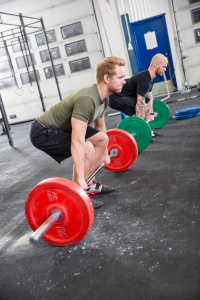Single Reps with Moderately Heavy Weights
 In this article, I will be discussing one more method for using single repetitions. Single repetitions are most commonly used in conjunction with very heavy weights relative to a lifter’s strength. When using lighter weights, people usually do sets of repetitions. However, there is no law that says you must do consecutive repetitions when using light weights. You can also choose to lift the weight once, then put it down, take a brief rest, and lift it again. The purpose of this is to minimize muscle fatigue which tends to be counter-productive to effective strength training.
In this article, I will be discussing one more method for using single repetitions. Single repetitions are most commonly used in conjunction with very heavy weights relative to a lifter’s strength. When using lighter weights, people usually do sets of repetitions. However, there is no law that says you must do consecutive repetitions when using light weights. You can also choose to lift the weight once, then put it down, take a brief rest, and lift it again. The purpose of this is to minimize muscle fatigue which tends to be counter-productive to effective strength training.
Methods For Using Single Reps with Moderate Weights
Using one rep with sub maximum weights is not a new idea, Olympic lifters do it all the time because it’s hard to do the clean and jerk and the snatch for consecutive repetitions. There was also a bodybuilding and strength building concept that’s been around for almost a decade called Max Stim. An abbreviated explanation of the Max Stim method is for a lifter to choose an exercise and a weight that they can perform for about 10 reps. However, instead of doing ten consecutive reps, the lifter does singles and starts out resting five seconds between each rep, making sure to actually put the weight down, or rack the weight between each rep. The lifter continues to do singles with 5 seconds between reps until rep speed starts to slow down. Once rep speed starts slowing down, the lifter rests ten seconds between reps and continues to extend the rest period to longer and longer time periods in order to recover enough to lift each rep with near maximum force. If a lifter can no longer continue lifting at near maximum rep speed with 30 second rest periods between each rep, they quit doing the exercise.
Another concept for using singles with moderately heavy weights is simply to use a consistent rest time between each single rep. A trainer by the name of Nick Nilsson uses this concept for a variation in his training. If you watch the video below, he does over 40 single reps of deadlifts, and uses a consistent rest period of 20 seconds between each single rep. This technique can be used for any exercise.
The nice thing about singles is that you can do a lot of reps without producing a lot of muscle fatigue. You don’t feel the fatigue while you’re lifting, but you may feel it the next day. About 13 years ago I used this method for bench press and dead lift. It shocked my body into a strength gain quicker than any method I have ever used. Even though it worked wonders on a short term basis, it’s not a method that kept working over the long run with the amount of single reps I was doing; I did too much.
Precision Point Methods for Using Single Reps with Moderate Weights
If you want to use this method on a regular basis in manner that allows for steady progression, then stick with the precision point concept of training as long as your strength is high. When your strength starts to decline, quit training that body part. For single reps, you can use precision point concepts a couple of ways.
The first method is to use weight that you can lift for about 10 to 12 consecutive reps, but do single reps with the weight and rest about 10 seconds between reps. When you reach a rep where your rep speed starts to slow down, stop the set and rest for at least 3 minutes. Then come back and do another set the same way. If you can reach the same number of strong reps as you could on your first set, you can keep repeating sets in the same manner with at least 3 minutes between sets. If your rep speed starts to slow down on a lower number than your first set, stop doing any more exercise for that body part.
A second version is to give yourself a full 20 seconds between single reps and keep doing singles until your rep speed slows down, then quit doing that exercise. You can repeat this in your workouts until it quits working, then you need to move on to a different way of training before you burn out. You can give it a try if you want to include a new variation in your training. Best of training to you.
